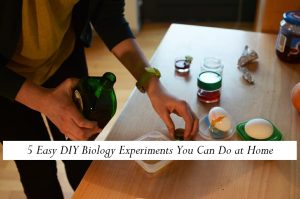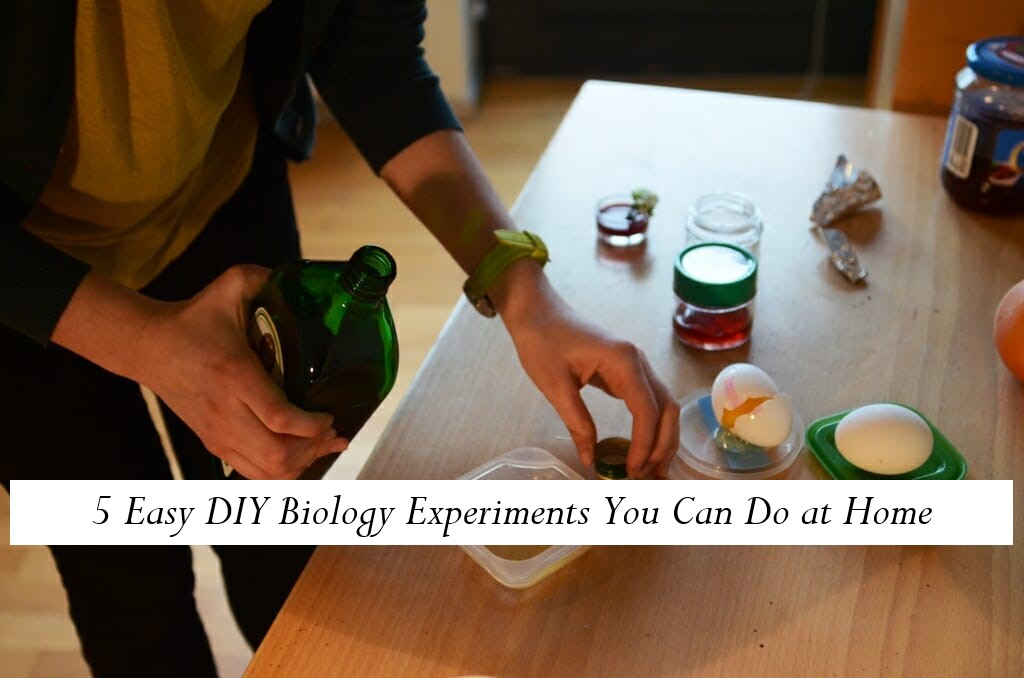
Biology is fascinating, but not all of us have access to state-of-the-art laboratory equipment to do biology experiments. However, it is possible to do some simple experiments at home with the right materials. These DIY biology experiments are suitable for all ages and levels of knowledge. The main goal is to have fun with science and get curious.
To be on the safe side, the list doesn’t include genetic engineering experiments; in many countries, you are not allowed to perform them in uncertified facilities. If you are very keen, though, some people have been able to get their homes certified to create genetically modified microbes.
1. Extract your own DNA
It is very easy to extract DNA at home just using everyday kitchen supplies. You can extract your own DNA from your saliva, or you can use any fruit or vegetable you can find at home — bananas and strawberries are some of the most popular at science fairs.
Follow the steps here to extract the DNA. At the end of the process, you should have obtained a white, cloudy substance that you can pick up with a toothpick. You can then observe it under a microscope, or try out some methylene blue, a dye commonly used in biology labs that binds to DNA and makes it turn blue — note that it should be used with caution outside a lab. If you dry the DNA and store it in a paper bag or envelope, you will be able to use it in future experiments.
It is also possible to analyze the extracted DNA at home, although this step can be more pricey. Equipment for electrophoresis, a technique to separate DNA molecules according to their size, can be bought from around €300. It can also be built at home with some dedication. If you want to take it a step further, you can get a pocket-sized DNA sequencer for around €1,000 — scientists often use this portable sequencing equipment when going to remote locations without access to a lab.
2. Culture bacteria on homemade agar
Bacteria, yeast, and other microorganisms are all around us. You can easily prepare culture medium at home and then collect samples from different places to find out what lives there.
In this video, you can find a step-by-step tutorial on how to make agar plates in your kitchen. Once you get some microbes to grow on the plates, you can experiment with how different conditions affect their growth or test the effect of antibiotics on the different microorganisms. (And if you have a DNA sequencer, you can use it to find which species are growing on your petri dish.)
For the creative souls out there, you can also make petri dish art by taking advantage of the different colors and textures of the different microbes you can find. Every year, the American Society for Microbiology runs a worldwide contest of agar art where you can submit your best creations.
3. Ferment your own food
Fermentation is one of the things bacteria and yeast make best. We’ve been using these microorganisms to make food since ancient times, and it’s quite easy to ferment your own food at home.
There are many options to choose from, ranging from drinks such as kombucha, kefir, or mead, to yogurt, cheese, kimchi, and sauerkraut. In most cases, what you need is just a starter culture of the bacteria or fungi that make the food you will be fermenting. You can get it from someone that is already doing fermentation at home, or buy them online.
Each fermented food has different requirements, so make sure you have everything you need before starting. There are plenty of online tutorials you can follow, and once you get comfortable with the techniques, you can start playing with different conditions and starter ingredients to modify the taste and texture of your food.
4. Look at cell division under the microscope
Nowadays you can easily find cheap digital microscopes with high magnification power that can be connected directly to your laptop or smartphone. You can take the digital microscope with you and observe every little thing you find at home or outdoors. (Tip: you’ll find many interesting forms of life in ponds or any other source of untreated water.)
A great experiment to do at home with a microscope is to look at how cells divide in different organisms. One of the easiest is baker’s yeast. With a magnification of at least 400x, you can start discerning the shapes of individual yeast cells in water. You will notice that some of them have little buds on them, which is the way they grow and divide.
The cells located at the tips of onion roots are also a very good subject of study. Whether you prepare and stain them yourself or you buy premade microscope slides, these cells are great to observe the different stages of mitosis and how the DNA gets duplicated and rearranged as the cells divide.
5. Make a bioluminescent lamp
Some microorganisms are able to generate light by themselves. When enough of them gather, they can make whole beaches glow at night. Luckily, we live in the age of the internet and it is possible to order these microbes online and get them delivered directly home. (For example, from shops like Carolina or Sea Farms.)
Bioluminescent organisms can last for several months under the right conditions, which includes making sure they receive enough light during the day to recharge their ability to glow. At night, they will start producing light when you shake them up.
You can experiment with growing these organisms in different conditions and play with their ability to make light. Another cool idea is introducing them into a closed fountain, where they will be constantly shaken and glowing (at least until they run out of energy).
———-
These biology experiments will get you started with the world of DIY biology. If you are keen to dive deeper into doing biology outside the lab, the DIY biology community is growing rapidly around the globe. You can find labs and other biology enthusiasts in many cities across Europe and the US, where you will be able to attend workshops, access more advanced equipment, and meet people from all backgrounds keen to help you with your wildest biology projects. Have fun! Check more at www.jyoungblood.com

